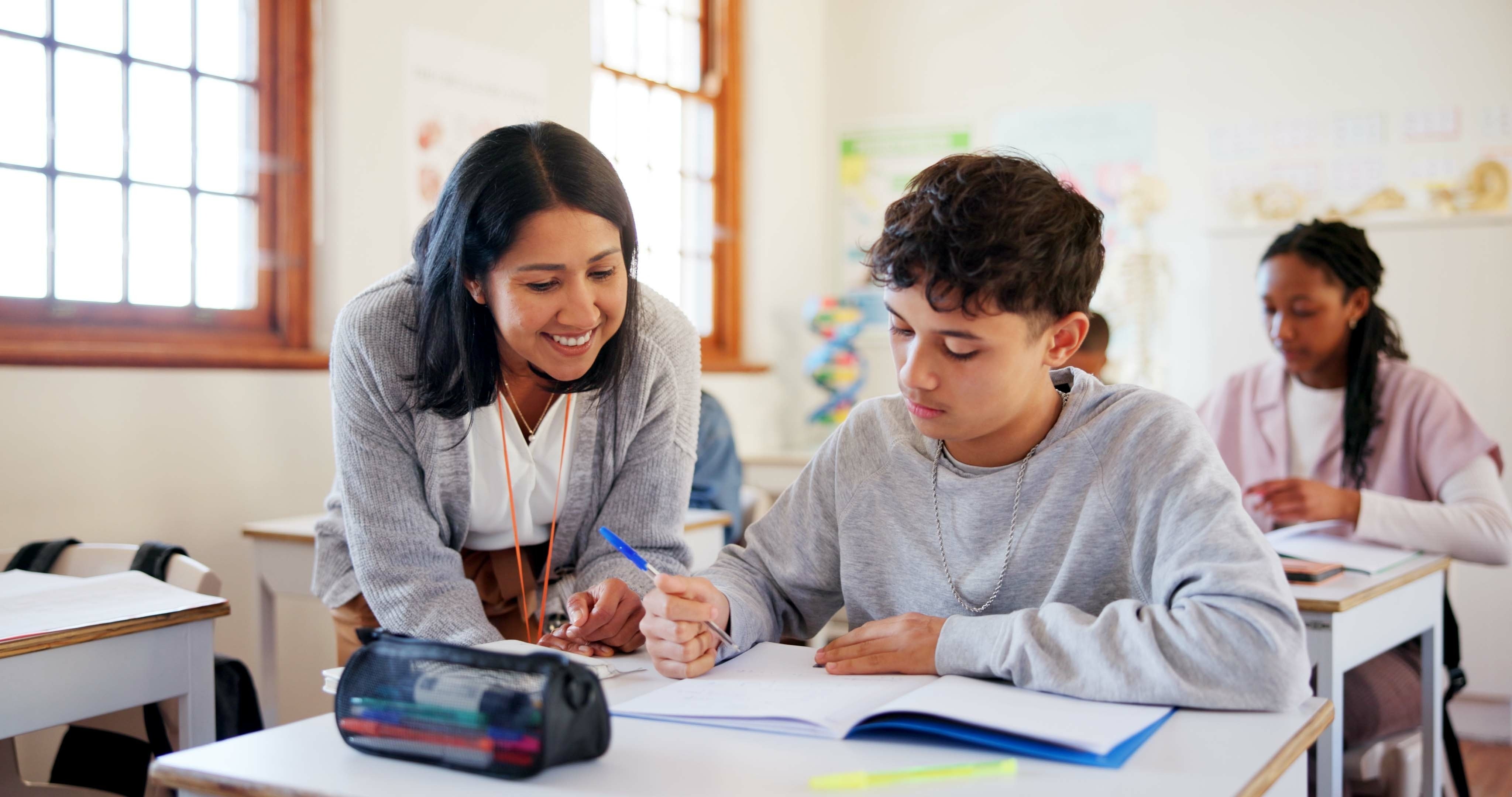Creating Normalcy for Boys Amid Uncertainty

When I first heard that the spreading Coronavirus would mean that we would need to move to a distance learning format, my thoughts quickly went to the changes it would mean in my ability to connect with my students. I have a group of four seniors who stop by to check in and chat with me every day about what is going on in their lives, so not seeing Jimmy, Peter, Adam, and Alex would mean that those moments of connection would be missing for all of us. Another student, Tyler, often does homework outside my office, stopping in for a piece of candy from the bowl on my table while sharing his thoughts on the books he is reading and the Netflix shows we both enjoy. He never fails to brighten my day. These are just a few of the many interactions that I have with students that might feel like small moments, but that speak to the connections forged between students and teachers. These young men are all students I have taught or counseled during the college selection process, yet our connections have continued to flourish beyond the topics in our classes or the process of completing applications. These connections serve as the foundation of what is special about our community… that we “know and love” the boys and young men both as learners and as human beings.
Michael Reichart, founding director of the Center for the Study of Boys’ and Girls’ Lives at the University of Pennsylvania and a long-time researcher on the topic of how boys learn, shared the following in his 2019 book, How to Raise a Boy, “What we found in our studies was that the power of connection to lift boys to new heights is nowhere as clear as it is in school.” He went on to note, “What teachers know from their lives in the trenches is that to reach any boy, they must build a relationship with him based on who he is as an individual.” If we are going to support our students in growing into the men they will become, that process has to happen not just through the delivery of content and skills (although those are certainly incredibly important), but through forging relationships with them where we acknowledge them as people of value beyond the intellectual work of the classroom.
But what happens when “known and loved” has to take place through a computer screen due to social distancing? How do we plan to keep the connections alive that have led to the success of our boys as learners thus far, and then extend them into the future weeks when we can’t physically gather together in person as a community? What role can parents play to support this new way of learning for their son?
As we moved to develop distance learning, we looked to those who had already had to do so: faculty and staff at schools around the world who had to move to learning in a remote format as they were closed by the spread of the virus. We didn’t want to stumble blindly toward a plan but wanted to take careful note about what had worked in this unprecedented scenario for others, hard-earned best practices from near and far. Sometimes months, sometimes just weeks ahead of us in their own distance learning endeavors, these teachers and administrators were surprisingly uniform on what they stressed as the key to successfully moving forward: maintaining connection and community. This didn’t come as a surprise to us, as this is what we do every day with our boys, but it was meaningful and grounding to hear so many other people articulate this view. In building our distance learning programs, we knew that what our high school students would need would look very different from what our primary and middle school learners would be able to manage. However, at the core, we created ways for students to connect with faculty and staff.
Maintain Community Connection
We have retained our important community moments of connection in new formats:
-
We prioritize time for boys to meet with their faculty advisors multiple times a week via videoconferencing.
-
Seniors will still follow our tradition of senior speeches to an assembly of adults and students; we’ll be seeing the speaker through the camera on his computer but our support will be as unwavering as it has always been.
-
We plan “lunches” online so that students can join to share a meal virtually, allowing for as much of the connection as possible to continue from our traditional school lunch tables where students and faculty advisors gathered to eat each day.
-
Teachers are recording videos of themselves reading books to build a virtual library for our youngest students. Seeing their teachers’ smiling faces while sharing stories is another powerful connection.
-
Virtual “office hours” are another important touchpoint. These scheduled times where adults are available for students (and parents in the lower grades) to “stop by” to ask questions about homework assignments, seek extra explanations on difficult topics, and connect, even if just to talk for a few minutes.
These examples reflect the way we build connections into our pedagogy even as we empower students to work in new ways. The adults in our community are purposefully maintaining connections with our students, knowing this is the best way we can support them in the social distancing climate. As our school’s consulting psychologist, Dr. Mark McConville, shared with us, purposeful and continuing connections with adults in the school community can provide much-needed “structures” for students in a time where it feels like so many of the usual relationship structures that buoy students have been taken away.
Our research revealed that trying to maintain the traditional school schedule was likely to result in burnout, stress, and frustration for both teachers and students. As educators of boys, we know that too much screen time is counterproductive, even when focused on educational topics, and that distance learning doesn’t lessen the impact of that knowledge. We wanted to offer a mix of times where students would be connecting with teachers online in synchronous learning and other times where students would be continuing their learning in asynchronous ways through individual assignments, research, hands-on work, or group work.
That mix would necessarily look very different for students across our three divisions; younger students have shorter attention spans and often need a parent or caregiver for some direction, while our high school students would manage their own learning in both formats but might need some help in initially structuring their time. Schedules that reflect the developmental stages of the boys, allow for both kinds of learning to take place in purposeful ways.
Finally, we knew that the key to a successful distance learning program would be the spirit with which we as a school community approached it. We knew there would be challenges and moments of frustration, but we also believed that we could join with our students and parents to work through the frustrations. We seek to develop in our boys the qualities of creative thinking and the ability to be flexible based on feedback. Here is an opportunity for the boys to see the adults in their lives demonstrating those very strengths with regard to their learning environments. We want our boys to see us moving forward with distance learning because we believe in a future beyond this time of crisis, we believe in their learning and their futures beyond these temporary constraints. If their teachers and parents continue to express this as we support them during this time, we know our students and sons will come out of this with important life lessons learned.
Preserving the School Community From Home
I’ve reflected on our school psychologist’s message regarding how the usual relationship “structures” around school are absent and can see how integral the role of parents in sustaining their son’s connections to school will be in the coming weeks.
-
Set up a space for a student’s learning to purposefully happen (or making sure the student has set it up, in the case of older learners). This is key, whether that is a corner of the kitchen table, a desk, or another spot where the parent knows the child will encounter minimal distractions while working or engaging with his teacher and classmates online.
-
Read the parent materials provided by teachers, help your son understand the activities he is doing when he gets stuck (particularly with younger students).
-
Be willing to reach out to the teachers with questions for how best to help your son.
Think of the ways in which the relationship your son has developed with his teachers matter so deeply to him; those connections are the bedrock of school for boys of any age. Keep those meaningful connections alive by talking about his teachers and the work they continue to do to further your son’s learning in this new educational setting. If your son wants to draw a picture, write a letter, send a video message, or email a teacher, facilitate that if at all possible. Not only will he make his teacher’s day in ways that go far beyond that simple gesture, but your son will be taking an active part in the continued development of the relationships that will make him a successful learner now and in the future.
These are challenging times by every measure. However, we will successfully navigate them precisely because of the connections, relationships, and community that our learners experience.
Subscribe to the Boys Education Series on iTunes or Stitcher
Jennifer Beros is the Associate Head of School and Interim Director of College Counseling at University School. She joined the faculty in 2011. Her career in education spans more than 25 years and has included teaching high school history and life skills, teaching middle school social studies and language arts, graduate research, and instruction at the collegiate level. Jen has presented at the national conference of the National Association of College Admissions Counselors and helped to initiate and coordinate many college programs for Cleveland Independent School students and parents. She earned her B.S. in Education, Cum Laude, from Miami University, her M.A. in Comparative Politics from American University, and her M.A. in Education from Ursuline College.



%202.jpeg)
